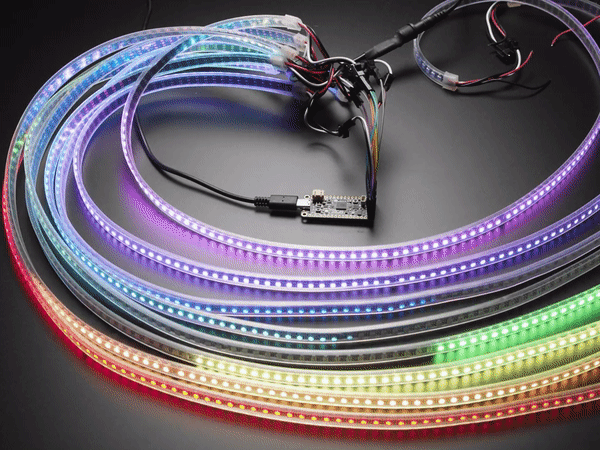The SCORPIO frees up the CPU for other activities by driving eight channels of NeoPixels from the RP2040's Programmable Input/Output (PIO) blocks.
The Feather RP2040 SCORPIO, a new development board from Adafruit that is based on the Raspberry Pi RP2040 microprocessor, is designed specifically to drive as many WS2812 RGB LED strips over eight channels as possible.
Mega-blinky-fun-rainbow-LEDs are what Adafruit is most known for, according to the company's introduction. "We just love sticking NeoPixels everywhere, and when we saw the new 'PIO' peripheral on the RP2040 from Raspberry Pi, we just knew it would be perfect for driving large quantities of NeoPixels, so we created this board, the Adafruit Feather RP2040 SCORPIO, designed specifically for NeoPixel (WS2812) driving but also useful for various PIO-based projects that want to make use of the Feather pinout with 8 separate consecutive output.
The Raspberry Pi RP2040 microcontroller, which has two Arm Cortex-M0+ cores running at a standard 125MHz and 264kB of RAM, is the foundation of the Feather-format board. 8MB of external SPI flash has been added by Adafruit, and a level shifter has been added to convert the chip's usual 3.3V output to 5V, or the other way around if you want to utilize the board's eight level-shifted channels as inputs instead of outputs.
Here, the Programmable Input/Output (PIO) blocks of the RP2040 steal the spotlight from the microcontroller cores. Direct memory access (DMA) has been used to load a state machine that Adafruit created specifically for creating perfect waveforms across eight concurrent outputs. As a result, the LEDs may be controlled without using up valuable CPU time.
The board includes two of each of the I2C, SPI, and UART buses in addition to two 5V LED outputs, four 12-bit analogs to digital converters (ADCs), 16 pulse-width modulation (PWM) outputs, an on-board RGB LED, a Stemma QT connector for solder-free expansion, and a 200mA+ lithium-polymer charging circuit with charging status indicator LED.
Although the board was shown as out-of-stock and not available to order at the time of writing, it had been offered for $14.50 at the Adafruit shop.















